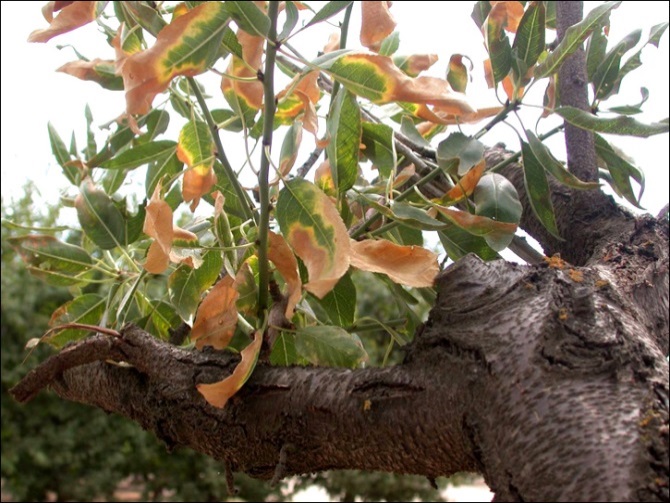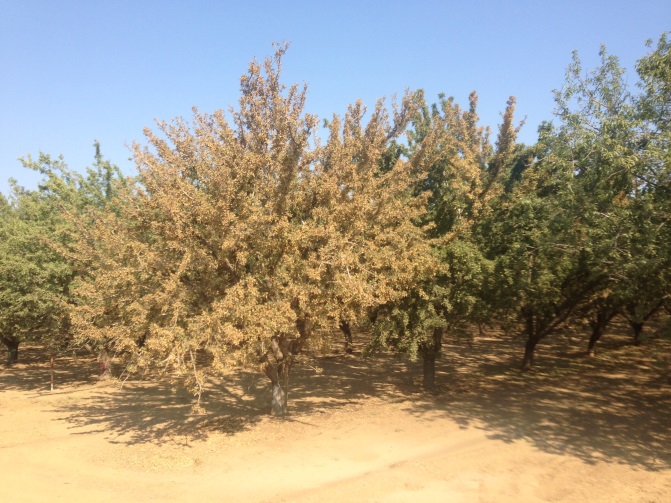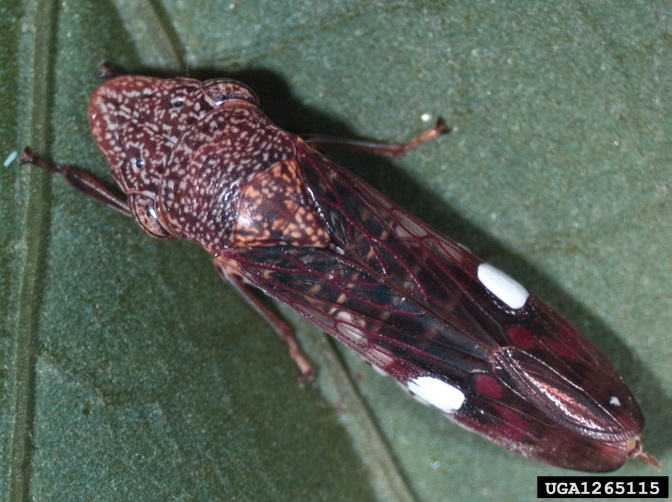
Bacterial leaf scorch in tree nuts
| Primefact number | Edition | Published | Author |
|---|---|---|---|
| 1444 | First | Mar 2016 | Plant Biosecurity and Product Integrity |



Bacterial leaf scorch (Xylella fastidiosa) is an exotic plant pest not present in Australia. Bacterial leaf scorch is a serious threat to Australia’s almond, macadamia and pecan industries.
Bacterial leaf scorch of tree nuts (also known as almond leaf scorch or golden death) is caused by the bacterium Xylella fastidiosa. The bacterium lives and multiplies in the sap, blocking water uptake to the leaves.
Sap feeding insects spread the disease between plants. Once a plant is infected there is no treatment other than to remove infected limbs or whole trees to try and prevent spread.
Xylella fastidiosa is responsible for a number of diseases in other horticultural crops, including Pierce’s disease of grapevine, citrus variegated chlorosis and alfalfa dwarf disease. No strains of Xylella fastidiosa are present in Australia.
Notifiable status
Bacterial leaf scorch (Xylella fastidiosa) is a notifiable plant disease in NSW.
All notifiable plant pests and diseases must be reported within 1 working day. You can report notifiable plant pests and diseases by one of the following methods:
- Call the Exotic Plant Pest Hotline 1800 084 881
- Email biosecurity@dpi.nsw.gov.au with a clear photo and your contact details
- Complete an online form
A full list of notifiable plant pests and diseases can be found in Schedule 2 of the NSW Biosecurity Act 2015.
Description
Bacterial leaf scorch symptoms first appear with the onset of warmer weather. The tips or edges of leaves initially turn light grey-green before developing a burnt or bleached appearance along the leaf margin.
The ‘burnt’ edge of the leaf progresses unevenly towards the mid rib and develops a golden yellow band between the dead part of the leaf and the inner green tissues (Figure 1).
Infected leaves eventually die and remain attached to the tree.
Symptoms may at first be isolated to one branch before spreading to the rest of the canopy over time. The alternative name ‘golden death’ comes from the golden yellow colour of the canopy of a severely infected tree (Figure 2).
Rate of spread within the tree is variable. It will often take several years for an entire tree to become infected, though in some cases the whole tree has become infected within a year.
Similar symptoms
Bacterial leaf scorch symptoms can resemble those of salt burn. Salt burn has an abrupt margin between the dead and healthy leaf tissue, with little or no intermediate yellowing. Salt burn is also more evenly distributed along the leaf margin compared to the uneven spread of bacterial scorch.
Damage
The presence of bacteria in the plant sap restricts flow of water and nutrients in the tree. Infected trees become stunted and less productive. Leaves die, flowering and fruiting becomes irregular and infected limbs die back.
There is no known treatment for bacterial leaf scorch once trees become infected. Susceptible plants will eventually die, however tees that become infected may still survive for many years if disease spread and tree decline is slow.
Spread
Xylella fastidiosa bacteria are carried in the sap of host plants and can be spread between plants by grafting, pruning or sap feeding insect vectors.
The most efficient known vector is the glassy winged sharpshooter (Figure 3). Glassy winged sharpshooter is not currently found in Australia. It is possible that natural insect vectors of this disease may already exist in Australia.
Introduction of the disease to Australia could occur with human assisted movement of infected plant material or with insect vectors. The disease is not carried on or spread by seeds.
Distribution
Xylella fastidiosa is native to the Americas and has spread to Europe where there has been recent detections in Italy and France. It is also present in the Caribbean, Taiwan, Iran, Turkey, Lebanon and Kosovo. Presence in India and Morocco is unconfirmed.
Alternative hosts
Many common weeds and grains including bermudagrass, rye, fescue grasses, watergrass, blackberry, elderberry, cocklebur, and nettle are hosts of Xylella fastidiosa and can serve as reservoirs of disease.
Overseas, common orchard weeds such as bluegrass, burclover, cheeseweed, chickweed, filaree, London rocket, and shepherd's purse have also been found to be infected.
Actions to minimise risk
Put in place biosecurity best practice actions to prevent entry, establishment and spread of pests and diseases:
- practice “Come clean, Go clean”
- ensure all staff and visitors are instructed in and adhere to your business management hygiene requirements
- monitor your crop regularly
- monitor and control weeds that can harbour both the disease and its vectors
- source plant material of a known high health status from reputable suppliers
- keep records

